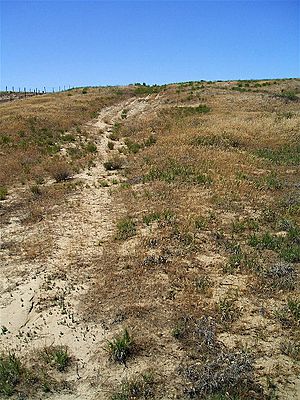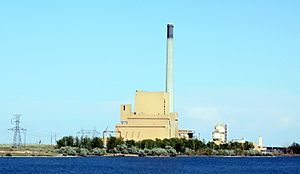Naval Weapons Systems Training Facility Boardman facts for kids
Quick facts for kids Naval Weapons Systems Training Facility Boardman |
|
|---|---|
| Morrow County, Oregon Near Boardman in the United States |
|

A sign on the range warning visitors of hazards related to testing.
|
|
|
Location of Boardman Bombing Range.
|
|
| Coordinates | 45°41′21″N 119°45′33″W / 45.68917°N 119.75917°W |
| Area | 47,000 acres (190 km2) |
| Site information | |
| Owner | Department of Defense |
| Operator | United States Navy |
| Open to the public |
Partial |
| Site history | |
| In use | 1941 - Present |
| Garrison information | |
| Current commander |
Chief Machinist’s Mate Steven P. Peña Jr. |
The Naval Weapons Systems Training Facility Boardman is a special military area in Oregon, United States. People often call it the Boardman Bombing Range. It's mainly used by the Naval Air Station Whidbey Island to train pilots. They test EA-18G Growler aircraft and also practice with drones here.
This training area was started in 1941 by the U.S. Army Air Force. It was first called the Arlington Bombing Range. The range is used often throughout the year. Besides the Navy, the Oregon National Guard also trains here. About half of the original land was given to non-military groups when the Air Force handed it over to the Navy. This area is also important for nature, with some parts being protected by the government.
Contents
Exploring the Boardman Training Range
This section tells you about the land where the Boardman range is located. It also explains why this area is perfect for military training.
Land and Location
The range is located south of Interstate 84 in a dry area called the Columbia Basin. This part of eastern Oregon is much drier than areas west of the Cascade mountains. The land has low plants like sagebrush. It slowly rises from near the Columbia River in the north to hills in the south. These hills reach about 870 feet (270 m) above sea level.
The Boardman Airport was first built as part of this training range by the Air Force. Now, it's owned by the local government, the Port of Morrow. The main gate to the range is on Bombing Range Road. This road connects Interstate 84 to Oregon State Route 207. Even though the Navy owns part of Bombing Range Road, it's open to the public.
Why This Location is Perfect for Training
The dry weather, quiet location, and flat land make this area great for Navy training. There are no rivers or lakes that flow all year round on the site. Water from rain and snow collects in two ponds that appear only at certain times of the year. These ponds were made a long time ago to help with ranching before the military took over.
History of the Boardman Range
This section explains how the Boardman range came to be and how it has changed over time.
The Oregon Trail Connection
A seven-mile part of the Oregon Trail is located inside the range. This part is called the Well Springs Segment and is listed as a historic place. This area is not bombed during training today. However, it was bombed a few times during World War II. The bomb holes from these tests did not harm the old ruts of the trail.
This historic section is rented to local ranchers for grazing animals. It also has an old pioneer cemetery, the remains of a stagecoach station, and a spring. The spring doesn't always have water now because of nearby wells used for farming. The cemetery is one of the biggest pioneer cemeteries known on the Oregon Trail.
How the Range Started
The War Department created the range by buying land between 1941 and 1943. It was used as a testing site for the Army Air Force during World War II. After the war, the Air Force continued to use it until 1960. Then, they gave about two-thirds of the land to the Navy. Smaller parts went to the state of Oregon and the Army Corps of Engineers.
When the Air Force gave up the land, it was in a mixed-up way. The state government and the Navy then worked together to give the range its current shape. The state has rented its part of the land to Boeing, which uses it to test antennas. The Navy still uses its part for weapons testing.
In 2012, a Chinese company bought a wind farm next to the range. Later that year, the Obama administration told the company to sell it. They believed the company might use it to harm national security. This was the first time such an order had been given since 1990.
Air Force Use of the Range
The War Department started the Arlington Bombing Range by buying 95,986 acres (388.44 km2) of land. This happened between 1941 and 1943. During these early years, the Boardman Airport was built. It was then known as the Boardman Flight Strip. During World War II, the Walla Walla Army Air Base used it for air-to-ground firing practice. After the war, the Army said the land was no longer needed.
In 1948, the Air Force started training on the site again. From 1952 to 1956, the 57th Air Division used the range. This division was based at Fairchild Air Force Base in Spokane, Washington. From 1948 until the Air Force stopped using the range, about 20 buildings, a flight strip, a gunnery range, and targets were built. The Air Force officially stopped using the land on August 11, 1960.
Changing Owners
In November 1960, the Air Force gave 58,375 acres (236.24 km2) of the land to the Navy. Another 37,320 acres (151.0 km2) went to the Department of Interior. A smaller part, 290 acres (1.2 km2), went to the Corps of Engineers. The land given to the Department of Interior later went to the state government.
The way the Air Force divided the land was like a checkerboard, which wasn't good for a bombing range. So, the Navy talked with the state. As a result, the Navy got its current range, which is in the eastern half of the original property. The rest of the land is now owned by the State of Oregon, Portland General Electric, and Morrow County. The Army Corps of Engineers still owns a small part, less than 14 acres (0.057 km2).
Current Use of the Range
Since the land deals were finished, the Navy has used the range for testing weapons at high speeds. In 1978, they set aside 4,750 acres (19.2 km2) for the Boardman Research Natural Area. This area is used to study native grasses and how to restore land. More talks about how the range affects the environment started in 2000. In 2015, the Navy built a new office building. This building has offices and can house six people. When the range is active, the airspace above it is restricted.
Boardman Research Natural Area
The Navy set aside 4,750 acres (19.2 km2) as the Boardman Research Natural Area. This area is inside the training facility. If you want to visit this area for study or experiments, you need permission from the Officer in Charge. You must write a report explaining why you want to visit before you can enter. This Research Natural Area is part of a national group of protected areas. These areas have natural ecosystems that are not disturbed. You cannot camp overnight here. Visitors usually stay in Boardman. The area is divided into three sections, A, B, and C, located near the center of the facility.
The soils in this area were left by the Missoula floods during the last ice age. You can find sand dunes in section C of the natural area. The plants here are mostly sagebrush steppe. Some plants include Russian thistle, snakeweed, and needle-and-thread grass. Several birds, like golden eagles, live here all year. Small animals like the long-tailed weasel and coyotes also live in this ecosystem. It's also a place where long-billed curlew birds nest during certain seasons.
Non-Military Activities
A large part of the original range was given to non-military groups. These include both government and private companies. The State of Oregon owns the biggest part of the former range. It leased this land to The Boeing Company. Boeing first planned to make a space park there. But later, they decided to use the land for farming. In 1974, they created a farming company called Boeing-Agri Industrial Company. This company faced a lawsuit about how it was taking water from a reservoir. Boeing also has a remote antenna range on the leased property. They use it to do tests for national security.
Portland General Electric (PGE) owns 3,520 acres (14.2 km2) to run the Boardman Coal Plant. This plant opened in 1975 and is one of the biggest polluters in Oregon. It produces about 15% of PGE's electricity. However, it is planned to close in 2020.
Future Plans for the Range
There are plans to make the facility even better for training. The Navy and Oregon National Guard want to train more at the range. They also want to bring in new aircraft like F-35's. They also plan to build new air-to-ground weapons systems. To do this, they need to build a new landing strip. They also want a place to service unmanned aircraft (drones). A second target area is also needed for these goals.
Besides air-to-ground training, the military also wants to create areas for ground training. These include a machine gun range, a digital range, a convoy live fire range, and a demolition range. Installing remote cameras would help with training. They would provide pictures to see how accurate weapons tests are.
Idaho Power is asking the Navy for permission to build 10 miles (16 km) of a new power line. This line would connect to a proposed power station that the Bonneville Power Administration plans to build near Boardman. This route through the range would avoid cutting through valuable farmland.
Images for kids








